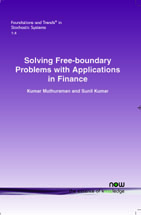Solving Free-boundary Problems with Applications in Finance
By Kumar Muthuraman, McCombs School of Business, University of Texas at Austin, USA, kumar@mail.utexas.edu | Sunil Kumar, Graduate School of Business, Stanford University, USA, skumar@stanford.edu
Abstract
Stochastic control problems in which there are no bounds on the rate of control reduce to so-called free-boundary problems in partial differential equations (PDEs). In a free-boundary problem the solution of the PDE and the domain over which the PDE must be solved need to be determined simultaneously. Examples of such stochastic control problems are singular control, optimal stopping, and impulse control problems. Application areas of these problems are diverse and include finance, economics, queuing, healthcare, and public policy. In most cases, the free-boundary problem needs to be solved numerically.
In this survey, we present a recent computational method that solves these free-boundary problems. The method finds the free-boundary by solving a sequence of fixed-boundary problems. These fixed-boundary problems are relatively easy to solve numerically. We summarize and unify recent results on this moving boundary method, illustrating its application on a set of classical problems, of increasing difficulty, in finance. This survey is intended for those are primarily interested in computing numerical solutions to these problems. To this end, we include actual Matlab code for one of the problems studied, namely, American option pricing.
Solving Free-boundary Problems with Applications in Finance
Stochastic control problems in which there are no bounds on the rate of control reduce to so-called free-boundary problems in partial differential equations (PDEs). In a free-boundary problem the solution of the PDE and the domain over which the PDE must be solved need to be determined simultaneously. Examples of such stochastic control problems are singular control, optimal stopping and impulse control problems. Application areas of these problems are diverse and include finance, economics, queuing, healthcare and public policy. In most cases, the free-boundary problem needs to be solved numerically. This volume presents a recent computational method that solves these free-boundary problems. The method finds the free boundary by solving a sequence of fixed-boundary problems. These fixed boundary problems are relatively easy to solve numerically. Recent results on this moving boundary method are summarized and unified, illustrating its application on a set of classical problems, of increasing difficulty, in finance. This volume is intended for those who are primarily interested in computing numerical solutions to these problems. To this end, actual Matlab code is included for one of the problems studied, namely, American option pricing.
